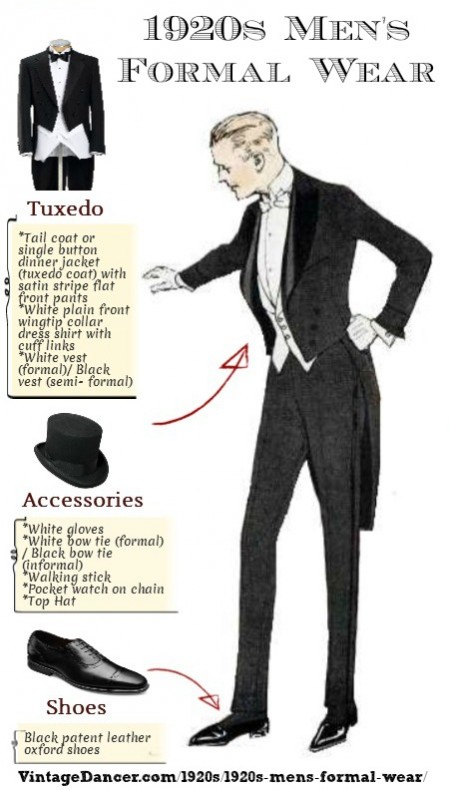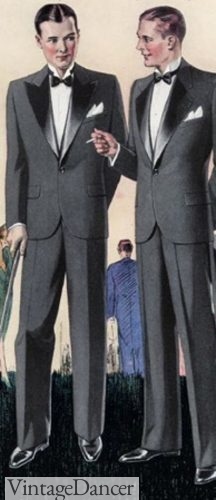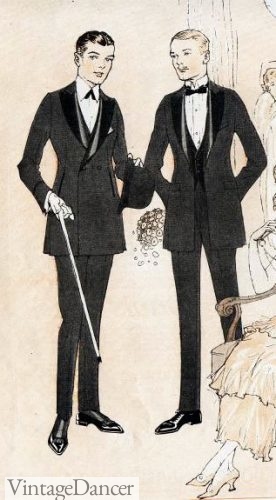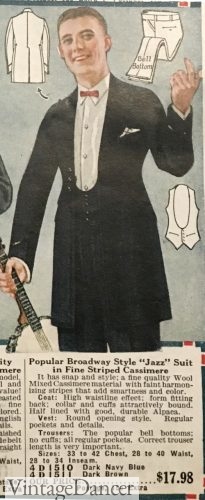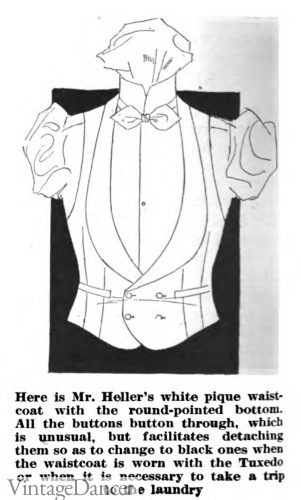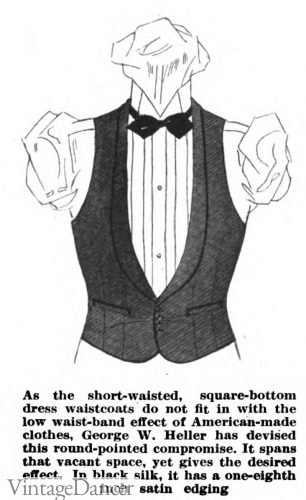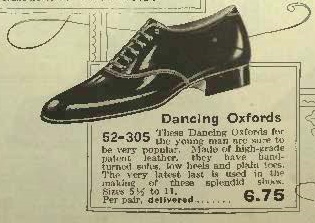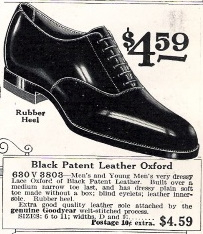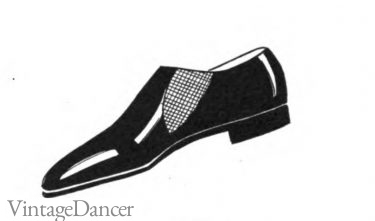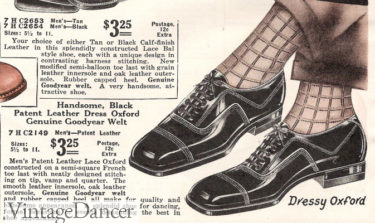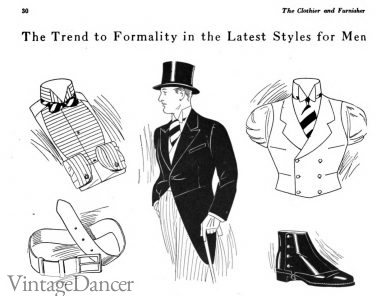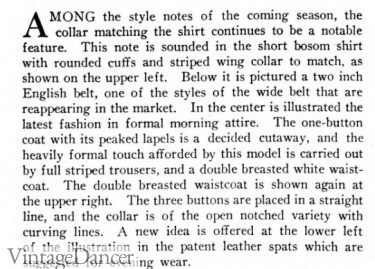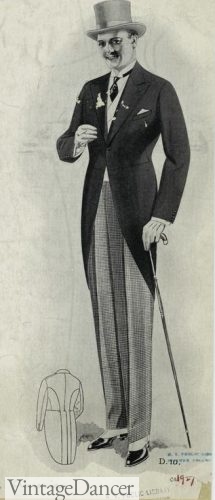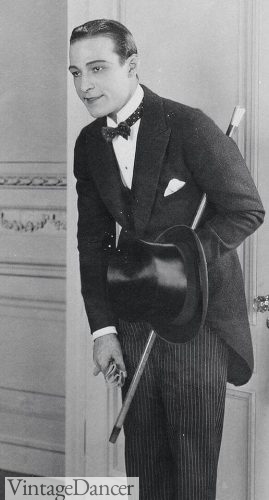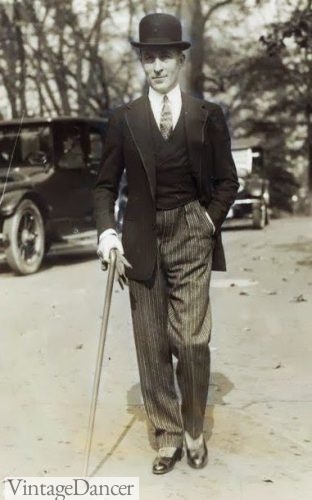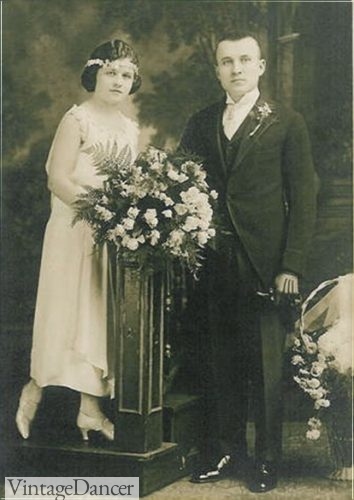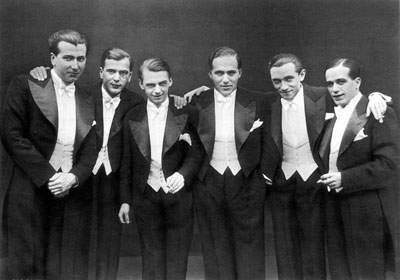
1920s Men’s White Tie Formal Wear
“Nothing Demands more impeccable taste than Dress Clothes.”- Brooks Brothers
An evening out to the opera, getting married, dancing at a formal ball, or attending a lavish dinner party meant it was time for men to dress in their finest evening attire. Entertainers and waiters also wore fine tuxedos as their uniform.
1920s men’s formal wear kept the traditional top hat and tailcoat as well as adding an option for a dinner jacket, called a Tuxedo coat today. There was also the formal morning suit that was worn to weddings and formal daytime events.
1910s men’s formal wear consisted of a black fitted jacket with long ‘swallow’ tails in the back, a white vest, trousers with silk stripes on the sides, and a white bow tie. While this “white tie” look continued to be fashionable in the 1920s, it was gradually losing favor.
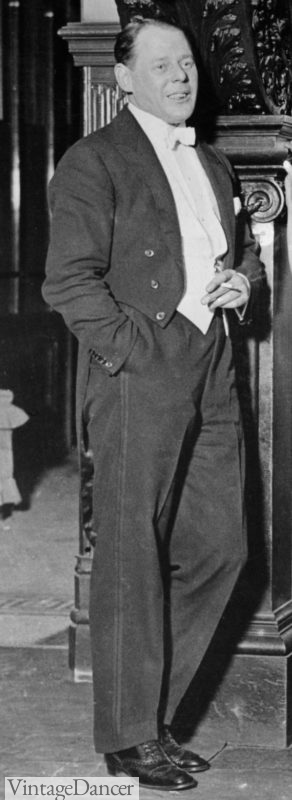
1924 Actor Guy Newell in white tie attire
Formal suits were almost always black, but dark navy blue saw use, too. The dark blue suit cut down on the appearance of dust, fibers, and pilling that are problematic with black suits under artificial light.
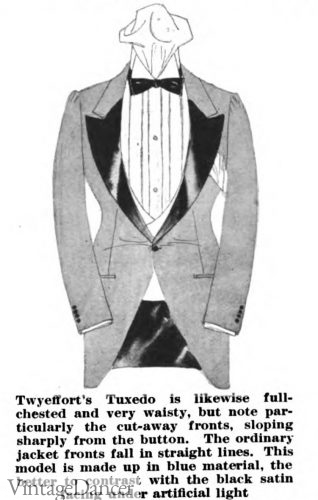
1922 a blue tuxedo coat with black satin lapel facing
To skip the history and begin shopping, click here for USA shoppers and here for UK shoppers. To rent a suit, contact your nearest rental house and ask if they have the style you want. The Men’s Warehouse has cutaways and other traditional tuxedos to rent in the USA.
1920s Tuxedo Jacket
The dinner jacket or tuxedo jacket replaced the tailcoat as an informal and more comfortable option. The exceptions were balls, galas, and the most formal of wealthy dinner parties.
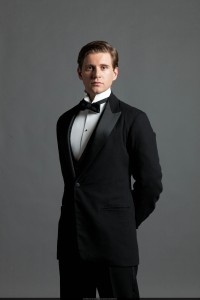
Downton Abbey – Tuxedo Jacket
The tuxedo jacket of the 1920s was still fairly long, falling below the hips. Thin notched or peaked lapels were the most fashionable, but they became wider as the decade progressed. Some jackets were cuffed at the wrists, too, sometimes with contrasting material, such as shiny satin or faille. They were mostly single-breasted with two buttonholes on either side of the jacket held together by a coat link. The coat link was similar in appearance to cuff-links.
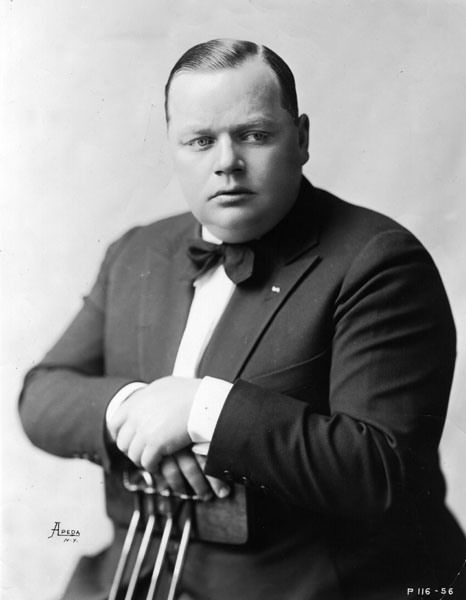
Roscoe ‘Fatty’ Arbuckle wears a peak lapel tuxedo coat
- Unusual black bow tie and white vest with a tuxedo jacket
- Peak and notch lapel dinner jackets
A double-breasted dinner jacket became popular in America in the late ‘20s. It was worn without a vest and eventually in the 1930s with an early form of cummerbund. Two flap pockets were usually found on the front, and a slit breast pocket made room for a white pocket square.
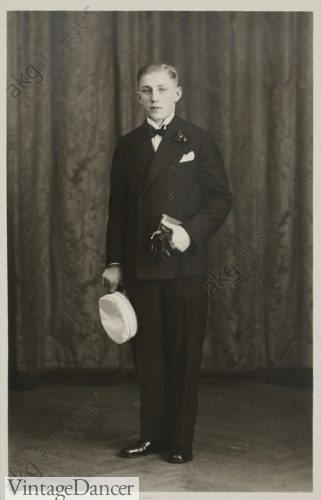
DB tuxedo for this Berlin man- Source
In the late teens and early twenties, there was a brief trend for the “jazz suit” dinner jacket. These were long single or double breasted jackets that fit snugly at the high waist and flared out over the hips. They were worn with very narrow trousers with a flared hem (called bell bottoms), a deep U or V black waistcoat without lapels, and a white smooth button down formal shirt. They were not restricted to only black and could also be dark navy blue, dark brown, or black pinstripe.
- 1919 “jazz suits”
- 1925 “jazz suit”
1920s Formal Trousers
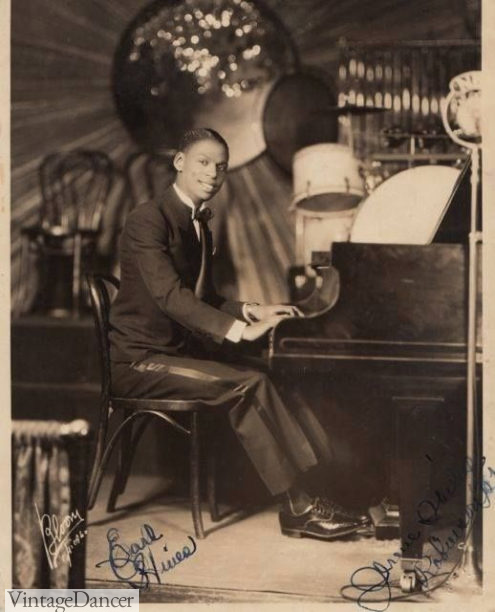
1929, Earl Hines wears tuxedo pant with silk stripe
Matching pants were worn with both tailcoats and tuxedo jackets. They were very high-waisted, coming above the natural waistline, and held up with suspenders. The trim on the side legs varied with the dress. For tailcoats, the trim was either two slim single or one wide double strip of silk braid. With dinner jackets, a single narrow braid was the only trim. Satin strips were the slightly less formal and more affordable trim.
Trousers had thin legs that taped down from the full hip to the ankle — but more so in the early ’20s, and they grew wider by the late ’20s. Unlike daywear, men’s formal trousers were uncuffed. Men’s black silk socks were visible, even while standing up. A sharp crease down the center gave a polished look.
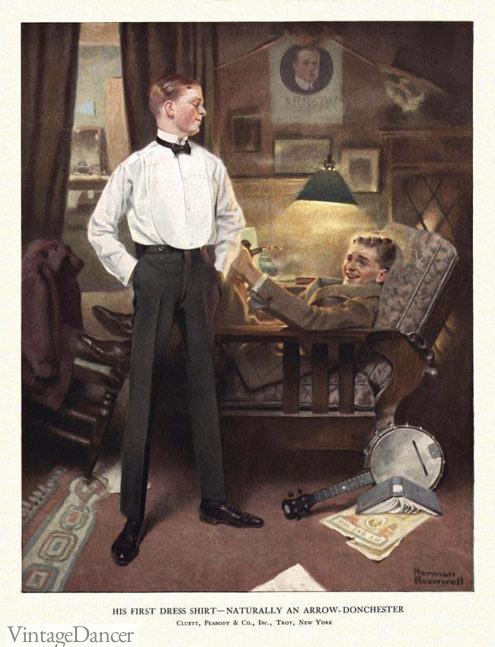
Formal bib front shirt and tuxedo trousers
1920s Formal Shirts
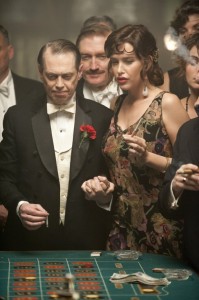
Nucky Thompson, Boardwalk Empire, Tuxedo Jacket, Vest, and Shirt
The formal dress shirt was traditionally a white cotton or silk bib front button up shirt with a detachable wingtip collar. Bib front shirts were starched stiff and smooth. Dress shirts buttoned up with shirt links made of white mother of pearl or black onyx. On the double cuffs (French cuffs) were a pair of initialed cuff links.
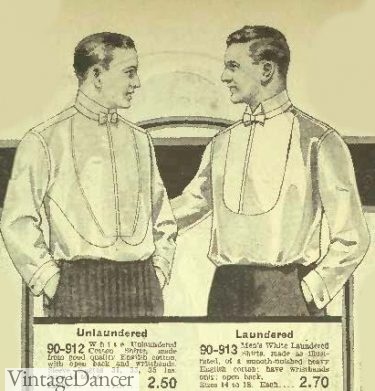
1920 bib front formal shirts
By the end of the 1920s, some young men (mostly Americans) tossed out the stiff bib front shirt in favor of a silk night shirt! These unstarched soft shirts with smooth or pleated fronts were certainly more comfortable and casual. They were only considered acceptable for summertime semi-formal occasions, although plenty of young men wore them to formal events, too. Pleated tuxedo shirts were only allowed with black tie accessories. They did not become mainstream until decades later and should be avoided for an accurate 1920s look.
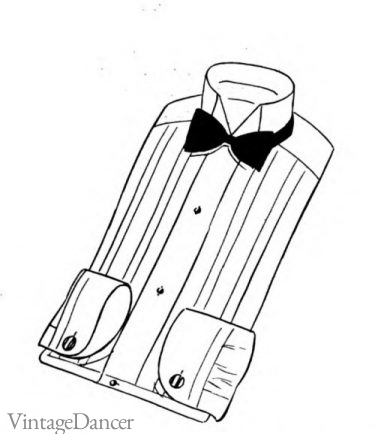
1924, a new side pleated wingtip tuxedo shirt with rounded cuffs
Shirt collars came in two varieties. The wingtip collar was the most formal and worn with white tie outfits. The classic fold down collar was worn with dinner jackets, but some men wore wingtip collars for dinner jackets as well.
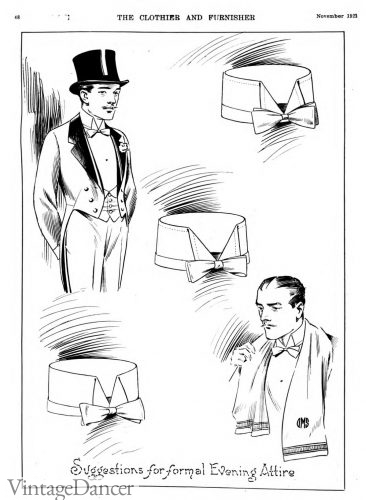
1922 wingtip collars and bow ties
1920s Formal Waistcoats / Vests
Over the shirt came a single- or double-breasted white or ivory waistcoat (vest) that hung over the top of the pants with curved edges or small points. The double breasted waistcoat was rounded along the bottom. A single-breasted vest usually came to two sharp points over the trousers.
Both black and white waistcoats featured a round and deep U shape shawl collar. These are notoriously difficult to find today.
For black-tie dinner jackets, a classic V neck, no lapel vest is accurate. The suit jacket was never unbuttoned while standing, therefore the vest was never seen.
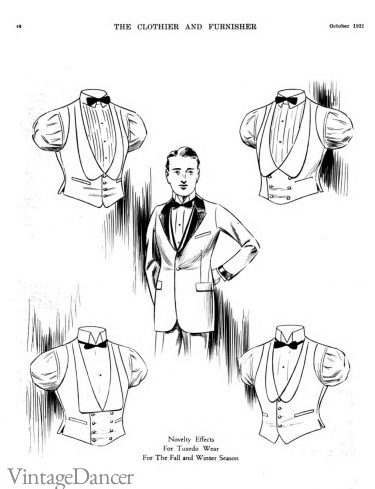
1922 men’s white tie waistcoats
White waistcoats were for the most formal occasions whereas ivory was the most common for everything else. Less prone to showing dirt, they were the more economical option and especially popular with a dinner jacket worn by young trendy men. Traditional men thought a white waistcoat with black dinner jacket was bad form.
- 1922 white waistcoat with shawl collar and a deep U/V opening
- 1922 black waistcoat, single breasted with shawl lapels
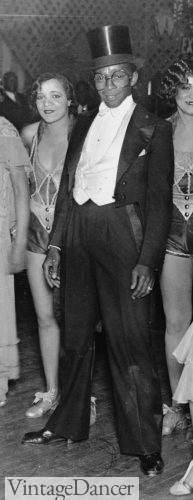
1929-Harlem, New York City: Picture shows an entertainer at Small’s Paradise Club Harlem. He wars a double breasted white waistcoat with shawl lapels.
The Prince of Wales made the backless vest very popular in the late ’20s. It attached around the back with just two straps. The lack of back fabric made it cooler to wear in warmer climates. Fred Astaire copied the Prince’s new fashion and also found the backless vest to be more comfortable while dancing.
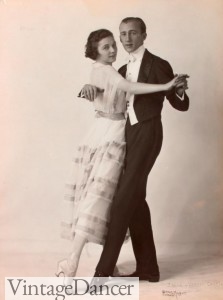
Dancers Vernon and Irene Castle
1920s Evening Accessories
A silk tie or bow tie was worn over the shirt collar in white (for white tie) and black (for black tie). The bow tie went from narrow to fat during the decade. Wingtip collars followed suit to accommodate the chunkier look.
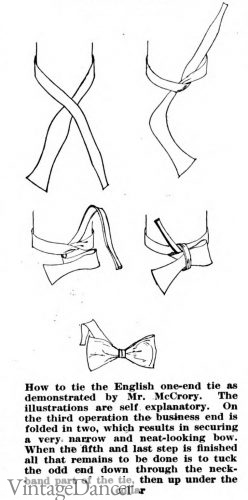
1922 how to tie an English bow tie
A white pocket square folded into the breast pocket of a tailcoat or tuxedo jacket was not a requirement in 1920 but was frequently used. Even with black tie attire, a white pocket square was used. A white carnation flower Boutineer was another decorative piece that was a personal choice of the wearer.
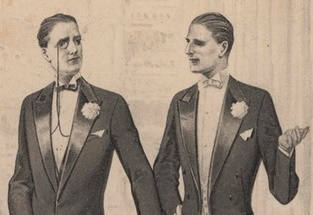
1920, bow ties, pocket squares and boutineer
White kid leather gloves with a button cuff were worn with a white tie suit but they were always removed during dinner, while smoking, and when drinking. Today it is easier to find white cotton gloves with a snap wrist with the name “parade gloves.”
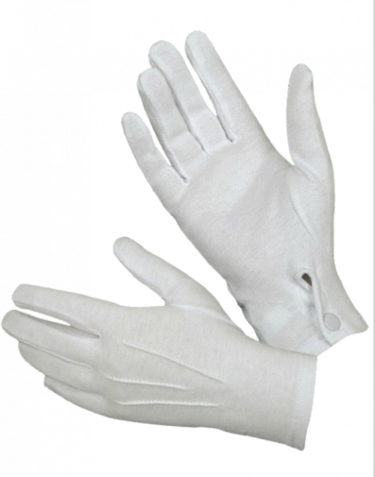
Formal white gloves with a button to snap at the wrist
Black patent leather slip-on pumps were the evening shoe of choice in the early years, with a small stacked heel and a slightly pointed round toe. These shoes were often worn with white or light grey spats (shoe covers). They were made from cotton canvas or linen and buttoned up the side. For eveningwear, the buttons had to be elegant in silver, gold, or shiny black onyx.
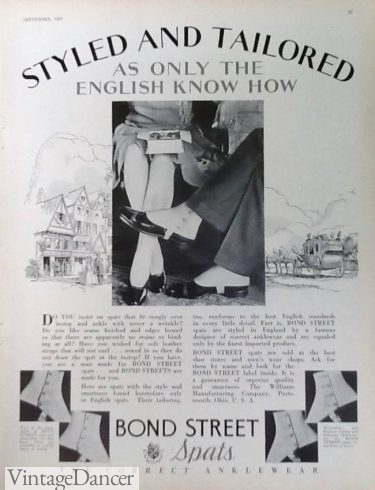
Bond Street spats for men
Patent leather lace-up Oxfords began replacing the slipper pump and spat shoes in the 1920s. At first, the shoe was very smooth with a plain patent leather body, but by the end of the decade the Jazz Age was jazzing up shoes in the evenings. Cap toe Oxfords with round or square toes made in patent leather was worn with black tie attire. The lace-less slip on pump could also be worn for dancing and informal (black tie) attire.
- 1920 smooth black dancing oxfords
- 1922 patent leather oxford shoe
- 1924 lace less pump for informal attire or dancing
- 1927 cap toe oxford patent leather dressy shoe
A gold or silver-tipped cane or classic crooked handle cane was a popular accessory for men in the 1900s that carried over into the early years of the 1920s. Young men found them too stuffy and they quickly went out of fashion.
A black silk or satin top hat completed the formalwear look. The hat was quite tall and narrow with an a 1-2″ thick brim.
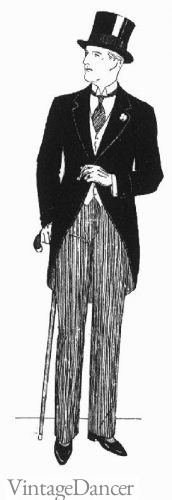
1920 Morning Suit
Formal Morning Suits
Up to now, we discussed evening wear, but there is one formal wear look that was worn early in the day: the morning suit. As the name suggests, it was a formal suit worn in the mornings or afternoon by wealthy businessmen, grooms, and for special British occasions like horse racing.
American men never fully embraced the morning suit in the 1920s. Some older generations of businessmen and political parties continued to wear them daily, as did as many wealthy grooms. Most weddings took place in the morning or early afternoon, so it was a natural fit for a groom to wear a morning suit.
- 1924 new trends in morning suits- a stripe bosom wingtip shirt, english belt, DB white waistcoat, and black patent shoe spats
- 1924 notes on the new trends
- 1927 morning suit of checked trousers, cutaway coat, grey top hat
- Rudolph Valentino wears morning attire with a black polka dot tie
- Jean Patou, 1924, fashion designer wears a Stroller coat
- A groom dressed in morning suit
The outfit usually consisted of:
- A black morning coat. Similar to a cutaway tailcoat, it has long tails but a curved jacket with a single front button/link. Dark grey was also acceptable. There was a brief trend to wear a Stroller, a longer black suit coat, instead of a morning coat.
- Black and grey striped or small check high waist trousers, no cuffs. Held up with suspenders or a hidden belt.
- A single- or double-breasted light colored waistcoat, usually ivory or buff. It could also be grey or black. Grey was not common but possible.
- Wingtip formal shirt (see above).
- An ascot in solid or striped pattern or bow tie is the most formal. A standard neck tie is acceptable for business. Pocket squares were optional. A flower boutonniere on the suit lapel was for weddings and special occasions.
- Polished black lace up Oxfords, smooth toe or cap toe. Black boots and white spats were also worn.
- Top Hat – Black silk or grey silk or wool (wool felt is easier to find). Derby or bowler hats are acceptable for informal business attire.
- Accessories: White, ivory, or yellow gloves. Walking stick or cane – black with a gold top or tightly rolled umbrella in inclement weather. Pocket watch on a chain hanging from the waistcoat. Cufflinks.
Morning outfits had less rules than evening attire. Men could mix other ties, vests, patterns, and hats to create unique looks.
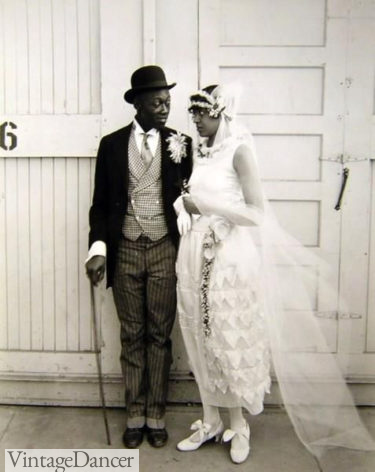
Dressed for a wedding in a morning suit with a check pattern vest. 1921
Dressing in 1920s Evening Wear Today
If you are attending a formal 1920s evening, then you will need a 1920s style tuxedo. Here are some tips to help you use readily available clothing for your authentic ’20s look.

1920s Tuxedo Guide
- You can get either a black or very dark blue modern tailcoat or a tuxedo jacket. Tuxedos should have notch or peak lapels with a single button closure (it will be easier to find a two-button jacket). Double-breasted coats are also acceptable. Avoid shawl collars, velvet fabrics, contrasting color lapels, skinny fit, and colored tuxedo suits.
Black tailcoats are relatively unchanged since the 1920s. Just avoid white or any other color. - Bib front dress shirts are hard to find. A plain white wingtip collar dress shirt will be a bit easier to find and look just as well. Avoid pleated tuxedo shirts, if possible.
- White or ivory waistcoats with the deep U shape are also hard to find, especially double-breasted. A single-breasted backless vest will be the most comfortable, just don’t remove your jacket while wearing it. Back vests will be easier to find and acceptable with tuxedo jackets. Choose a deep V neckline and avoid shiny satin materials.
- Tuxedo pants with braids are impossible to find. Flat front tuxedo pants with satin stripes on the sides will be acceptable. Order one size up if you want a higher waistline and hold them up with black suspenders. Avoid pleated tuxedo pants and very stretchy elastic suspenders (they stretch too much and your pants will fall down). Modern fit/skinny fit/ trousers usually have a very low waist. Avoid these and choose a classic fit.
- For white tie, choose a white vest with white bow tie and optional white pocket square. For black-tie, choose a black vest, black bow tie, and optional white pocket square.
- Choose black patent leather Oxford shoes. Standard matte black shoes are ok in a pinch. Please clean and shine them up. Wearing spats over your shoes is an option for white-tie attire.
- Add snazzy accessories such as a cane, pocket watch, boutineer, cufflinks, spats, gloves, flask and ???. Make it your own and have fun! Shop here for accessories.
- You can find all of these formal clothes for sale here (USA) and here (UK).
To rent a tuxedo or morning suit visit The Men’s Warehouse online.
If you need more help with your look, just ask.
Debbie Sessions has been teaching fashion history and helping people dress for vintage themed events since 2009. She has turned a hobby into VintageDancer.com with hundreds of well researched articles and hand picked links to vintage inspired clothing online. She aims to make dressing accurately (or not) an affordable option for all. Oh, and she dances too.
